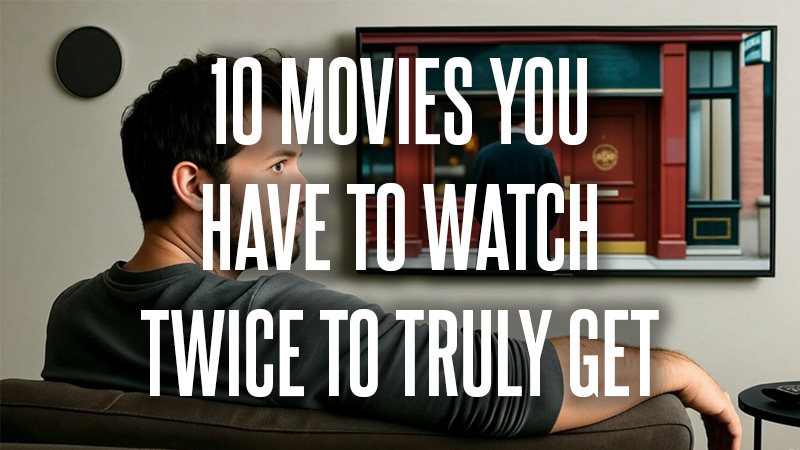10 Movies You Have To Watch Twice To Truly Get
Some movies entertain you. Others knock you over the head, steal your popcorn, and dare you to keep up. Then there are the special few that don’t fully reveal themselves the first time around. You leave the theater (or your couch) thinking, “Wait… what just happened?” and before you know it, you’re pressing play again, determined to connect the dots you missed while blinking.
These are the films that reward patience, curiosity, and maybe a quick Google search afterward. They’re layered, clever, sometimes deliberately confusing, and almost always unforgettable. A second viewing doesn’t just make them clearer. It often transforms them.
Here are 10 movies you have to watch twice to truly get, the films that invite you back like a mischievous friend with secrets to spill.
Inception (2010)
Christopher Nolan’s Inception practically comes with a built-in disclaimer: “May require more than one viewing to fully understand.” On its surface, it’s a high-concept heist movie. But instead of cracking safes, this crew breaks into dreams. And not just one dream. Dreams within dreams within dreams. By the time the van is still mid-fall in the third act, half the audience is mentally reaching for a whiteboard.
The brilliance of Inception is that it works both as a thrilling action film and a puzzle box. On a first watch, you’re swept up by the spectacle. The spinning hallway fight, the folding cityscape, Hans Zimmer’s foghorn of a score, it’s overwhelming in the best way. On the second watch, though, you start noticing the mechanics. You catch how time dilation works differently in each layer, how Cobb’s totem is more about his emotional state than plot trickery, and how Nolan subtly tells you what’s real through sound design.
And then there’s that ending. The spinning top has fueled more debates than most philosophy classes. First viewing: shock. Second viewing: obsession. By the third, you might start questioning your own reality. Good luck.
Fight Club (1999)
The first rule of Fight Club is… yeah, yeah, we know. But the real first rule should be: you have to watch it twice. David Fincher’s cult classic is more than just a nihilistic ode to underground brawls and soap-making. It’s a razor-sharp satire and a psychological thriller hiding in plain sight.
The big twist, that Tyler Durden is the narrator’s split personality, lands like a punch to the gut on a first watch. Everything you thought you knew about these characters shatters in an instant. But it’s on the second viewing where the film truly reveals itself. Suddenly, every interaction plays differently. Tyler’s absences, the way other characters look at “both” of them, and the casual acceptance of chaos all click into place.
Fincher is meticulous in how he hides and reveals information. There are subliminal flashes of Tyler early on, framed conversations where he’s clearly not “really” there, and carefully structured dialogue that makes sense only in hindsight. The film morphs from anarchic thrill ride to psychological chess game the second time around. And yes, it still holds up.
The Prestige (2006)
Christopher Nolan appears again, because of course he does. The Prestige is his magic trick of a movie, and like any great illusion, you need to see it twice to catch how he pulled it off. The film follows rival magicians Alfred Borden (Christian Bale) and Robert Angier (Hugh Jackman) as their obsession with outdoing each other leads to increasingly dangerous consequences.
On first watch, you’re swept along by the rivalry, the performances, and the deliciously dark tone. The final reveals, Borden’s twin and Angier’s cloning machine, are shocking. But when you go back, you realize Nolan told you everything from the start. Cutter’s opening monologue lays out the three acts of a magic trick, which mirror the film’s structure. Borden’s double life is hiding in plain sight in scene after scene. Even the way characters address “Borden” hints that something’s off.
The second viewing turns The Prestige from a twisty thriller into a perfectly constructed narrative machine. You don’t just see what happened. You see how carefully Nolan built the misdirection, like a magician showing his hand if you’re looking closely enough.
Mulholland Drive (2001)
David Lynch doesn’t make films you understand in one sitting. He makes cinematic riddles, dreamscapes, and fevered hallucinations that refuse to explain themselves. Mulholland Drive might be his most infamous puzzle. The film begins like a neo-noir mystery, then shifts into something far more surreal. Halfway through, identities blur, timelines collapse, and the line between fantasy and reality dissolves entirely.
The first viewing is disorienting by design. Lynch drops breadcrumbs, a mysterious blue box, an unforgettable scene behind Winkie’s diner, strange doubles, but never holds your hand. On the second viewing, though, patterns start to emerge. You begin to see the first half as an idealized fantasy constructed by Diane, with the second half revealing the tragic reality she’s trying to escape. Symbolism that seemed random becomes purposeful. Dialogue echoes back with new meaning.
Lynch once famously handed out “10 clues to unlocking the film” for confused viewers, but honestly, the best clue is just watching it again. Mulholland Drive doesn’t give up its secrets easily. That’s why it lingers.
The Sixth Sense (1999)
When The Sixth Sense came out, its twist ending became the stuff of legend. M. Night Shyamalan pulled off one of the great cinematic sleights of hand, and audiences left theaters buzzing. On a first watch, the revelation that Dr. Malcolm Crowe (Bruce Willis) has been dead the entire time is a genuine shock. On the second watch, it becomes a masterclass in how to hide something in plain sight.
Shyamalan meticulously structures every scene to support the twist. Characters never directly acknowledge Malcolm. The dinner scene between Malcolm and his wife plays like a lovers’ quarrel, but in reality, it’s her grief. The “cold spots” take on new significance. Even the color red, subtly woven throughout, points to the supernatural.
The second viewing transforms the film from ghost story to intricately built puzzle. You appreciate the elegance of the construction. It’s like watching a magician perform a trick twice: first in wonder, then in admiration.
Donnie Darko (2001)
Richard Kelly’s Donnie Darko is practically a rite of passage for film lovers who enjoy scratching their heads. On the surface, it’s a story about a troubled teenager (Jake Gyllenhaal) who starts seeing a terrifying man in a bunny suit named Frank. But beneath that is a time loop, alternate universes, and metaphysical concepts that can make your brain short-circuit if you’re not paying attention.
The first viewing is often a swirl of strange images, cryptic dialogue, and mood. The second viewing is where the pieces start fitting together. You catch how the jet engine crash connects to the tangent universe, how characters’ seemingly random actions are part of a closed time loop, and how Donnie’s sacrifice resets reality.
Kelly’s Director’s Cut explains more explicitly, but even the theatrical version rewards patient rewatchers. It’s less about solving every riddle and more about recognizing the structure beneath the chaos. And yes, Frank is still terrifying.
Arrival (2016)
Denis Villeneuve’s Arrival is one of those rare films that becomes a completely different story the second time you watch it. On the first viewing, you follow linguist Louise Banks (Amy Adams) as she tries to communicate with alien visitors. The narrative seems straightforward, but the emotional throughline about her daughter appears as flashbacks scattered throughout.
Then the twist lands: these aren’t flashbacks. They’re glimpses of the future. Time in Arrival is non-linear, and Louise’s learning of the alien language rewires her perception. On second viewing, every “memory” scene takes on new resonance. You notice how the film subtly telegraphs its structure through framing and editing.
The rewatch transforms Arrival from a mystery into a profoundly emotional meditation on language, time, and choice. Once you know the ending, the opening scene hits like a freight train. Bring tissues.
Interstellar (2014)
Christopher Nolan’s Interstellar is emotionally stirring on the first viewing and intellectually richer on the second. The first time through, you’re likely overwhelmed by the spectacle, wormholes, black holes, time dilation, and that thunderous Hans Zimmer score that feels like a pipe organ in space. It’s breathtaking, but it’s also dense.
On the second viewing, the intricacies of the plot become clearer. The time dilation sequence on Miller’s planet, where an hour equals seven years, hits harder when you fully understand the consequences. The ghost in Murph’s room takes on tragic significance. You pick up on the foreshadowing in Cooper’s relationship with NASA, and the tesseract sequence becomes less of a head-scratcher and more of an emotional payoff.
Interstellar thrives on dual layers, the scientific and the human. The first viewing lets you feel it. The second lets you understand it.
The Usual Suspects (1995)
Bryan Singer’s The Usual Suspects is a crime thriller built like a trapdoor. The entire story is told through the perspective of Verbal Kint (Kevin Spacey), a seemingly meek conman recounting how a group of criminals got tangled up with the mysterious Keyser Söze. The first viewing is a gripping mystery with twists and turns that lead to an iconic reveal.
The second viewing, though, is where the magic happens. Once you know that Verbal is Söze, every line, every gesture, every piece of his story changes meaning. You see how he weaves details from the office into his elaborate fabrication. His stammering innocence becomes a mask. The entire film transforms from a procedural thriller into a showcase of narrative manipulation.
Few films pull off this level of rewatchable deception. The ending is famous, but the rewatch is where you see just how well the trick was performed.
Blade Runner (1982)
Ridley Scott’s Blade Runner is a film that seems to deepen every time you revisit it. On the first viewing, you might get caught up in the neon-soaked visuals, the rain-drenched noir aesthetic, and the replicant-hunting storyline. It’s a feast for the senses. But beneath that, Blade Runner is a meditation on identity, humanity, and memory, and those layers only become richer the second time around.
The ambiguity surrounding Deckard’s own identity, the meaning of the unicorn dream, and the nuances of Roy Batty’s arc all come into sharper focus. Lines that seemed straightforward start to feel loaded. Visual motifs repeat in ways that only register once you know where the story ends.
And of course, it doesn’t hurt that there are multiple cuts of the film, each adding their own interpretive wrinkles. Whether you prefer the Final Cut or the original theatrical version, Blade Runner is a film that practically begs for analysis.




